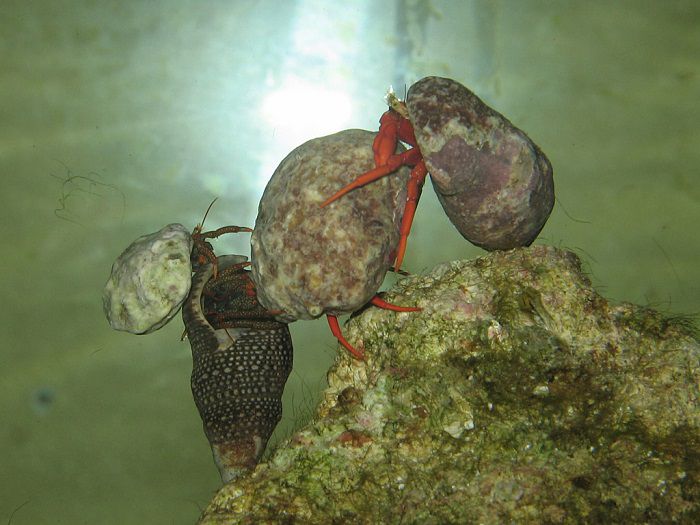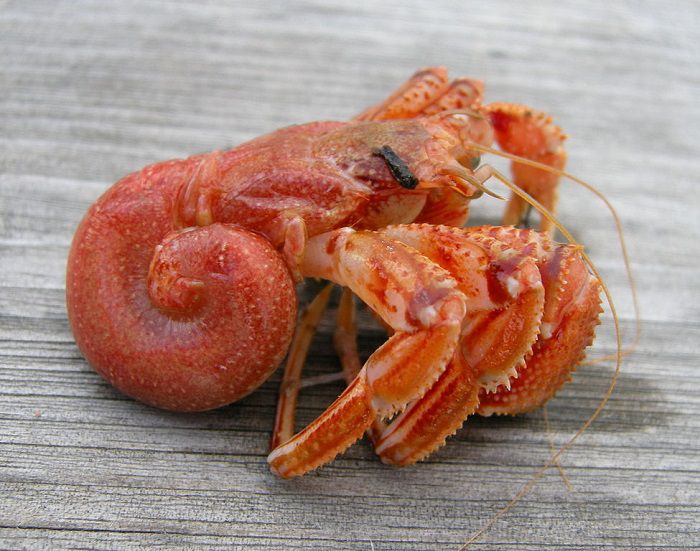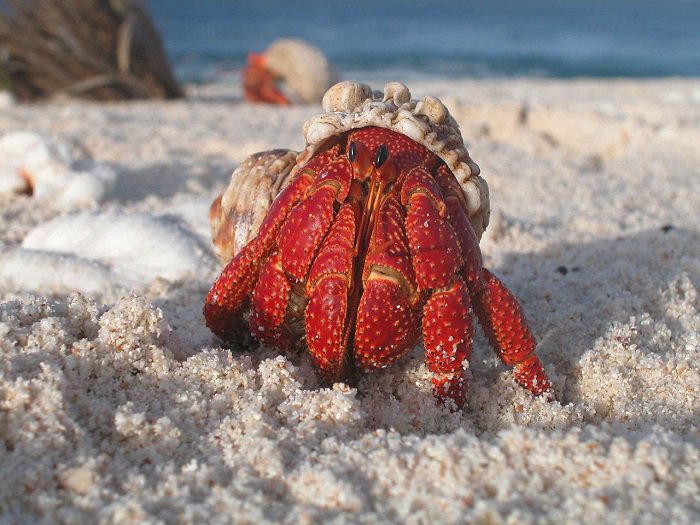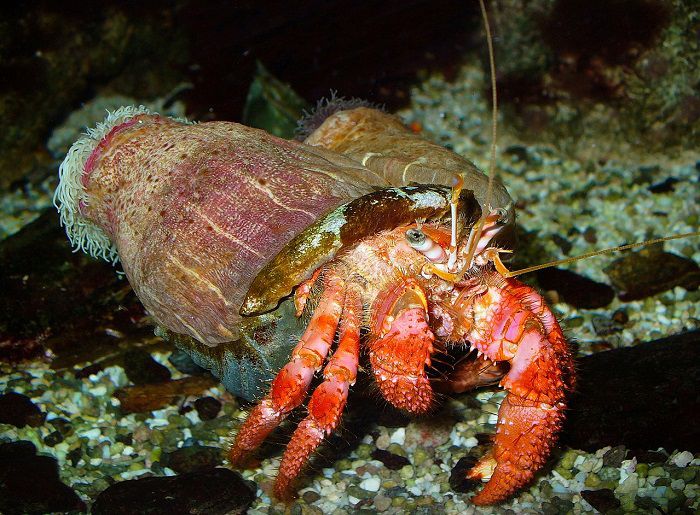Table of Contents
For new and inexperienced hermit crab owners, the sound of their pet making a chirping sound similar to that made by birds can be surprising. In fact, many new owners will not instantly realize that the faint chirping sound they are hearing is actually coming from their hermit crab.
There are times though when this chirping sound becomes more like a squawking, and it can be quite loud. In this case, there is obviously no mistaking where that sound is coming from. So, why do hermit crabs chirp?
chirp?
What Does Crab Chirping Mean?
Most hermit crab owners believe that chirping is a sound their crabs make when they are stressed or agitated. How loud this chirping is will typically determine how stressed the crab is.
If you have more than one hermit crab in your tank, you might notice that one will make noise when another is bothering it. Hermit crabs often crawl over each other, and sometimes they will get into a dispute over a specific shell.
If a hermit crab is frightened, it might make a louder noise before scurrying inside its shell. This can often occur when they are first brought to their new homes and are trying to get accustomed to their surroundings.
The Different Types of Noises Hermit Crabs Make
Hermit crabs are intriguing creatures, displaying a surprising range of sounds, each signifying specific behaviors or conditions. The most commonly known sound, as we have discussed, is the chirping or squeaking sound, often a result of stress or discomfort. But, beyond this, they produce other types of noises too.
Squawking
Firstly, squawking – a louder, more persistent noise than chirping – could indicate a higher level of distress or agitation. It can be triggered by factors such as a territorial dispute or an uncomfortable environment. If you hear your crab squawking, it’s worth checking to ensure there are no immediate threats in its habitat.
Rattling
Another type of noise is the rattling sound. This noise is not caused by the crab itself, but by the movement inside its shell. It’s typically heard when a hermit crab is about to change shells or is just adjusting its current one. It’s a normal part of their behavior and doesn’t usually indicate any problem.
Scratching
Scratching sounds, another common type of noise, are usually linked to the crab’s feeding or digging behavior. Hermit crabs are notorious diggers, and the scratching noise you hear is likely just them maneuvering through the substrate in their tank.
Clicking
Finally, there’s the clicking sound. This can be heard when hermit crabs communicate with each other, especially during interactions involving a desirable shell. This clicking sound can be quite faint, so you’ll need to listen closely to pick it up.
Each noise a hermit crab makes gives you insight into their well-being or their current activities. By learning to decipher these sounds, you can become a more attentive and understanding caretaker, fostering a better relationship with your unique pet.



How Do Hermit Crabs Make Noise?
You might be interested to know how hermit crabs actually make sounds. Unlike other animals such as cats and dogs that make noise through their tracheas, hermit crabs make sound by rubbing certain parts of their body together. This is known as stridulation and is also how crickets make their familiar chirruping sound.
While crickets rub their wings together to make sound, hermit crabs rub different parts of their body, such as their legs, together inside their shells. The sound of their body parts rubbing against the shell is that which makes the chirping sound and is why it sometimes comes across as muffled.
The Role of Shell in Sound Production
Undoubtedly, the iconic shell of a hermit crab is far more than just an adorable mobile home. It serves as a crucial part of their survival strategy, providing protection, assisting in hydration, and even playing a significant role in their unique sound production.
Hermit crabs generate sound primarily through a process called stridulation, similar to crickets (touched upon above). But rather than rubbing wings together, hermit crabs stridulate by swiftly rubbing specific parts of their body, often their legs, against the inside of their shell. Think of it as a miniature violinist, with their legs being the bow and the shell acting as the instrument’s body.
The Shell as a Natural Amplifier
What’s truly fascinating about this process is how the shell acts as a natural amplifier, much like the body of a guitar or violin. The hardness and shape of the shell work in tandem to enhance the vibration produced by the stridulating crab, amplifying the sound so it can travel further. The shell’s unique properties cause the vibrations to resonate, creating the distinct chirping sound we associate with these crabs.
This is why the sounds emitted by hermit crabs might come across as somewhat muffled, or even resonate differently depending on the size and shape of their shell. It’s as if each hermit crab is playing a slightly different instrument!
Hermit Crab Shell Preference and Sound Variation
The choice of shell can also affect the type of sound a hermit crab produces. Hermit crabs are known to be particular about the shells they choose to inhabit, preferring certain types and sizes. This selection directly impacts the type of sound they create, as the shell’s size, thickness, and material all play a part in determining the sound’s frequency and volume.
Hence, your hermit crab’s individual ‘voice’ is a fascinating blend of their own unique stridulation patterns and the acoustic properties of their chosen shell. This complex interaction truly emphasizes the integral role the shell plays in the sonic behavior of these fascinating crustaceans .
.
Should You Be Worried About Chirping Hermit Crabs?
A chirping hermit crab is nothing to worry about. Nevertheless, if your crab is making this sound when you approach, it is best to leave it be for a while. It may be getting ready to molt and might therefore see you as a threat.
If your crab is new, it could be stressed out due to its recent capture and subsequent move to your home. It is important to allow the crab to get used to its new surroundings and try not to disturb it too much. Let it get used to the new tank without handling it and make sure it has access to food and water. You should also ensure that temperature and humidity levels are correct. You can monitor these by investing in a good quality thermometer and humidity gauge purchased online or from a local pet store.
Humidity levels should range between 70 and 80 percent while the tank temperature should be anywhere between 72F and 82F, with a cool and warm end to allow your crab to move to and from as it gets too hot or cold.
No products found.
Common Causes of Stress in Hermit Crabs
Hermit crabs are remarkable creatures with their own unique set of needs and behavioral patterns. Just like other pets, they too can experience stress due to a variety of reasons, and understanding these can go a long way towards ensuring the wellbeing of your tiny crustacean friend.
Change in Environment
One common source of stress for hermit crabs is sudden change in their environment. Hermit crabs are highly sensitive to the conditions of their habitats such as temperature, humidity, and lighting. Any drastic changes in these conditions can cause stress. For instance, if the tank’s temperature drops significantly or rises abruptly, your hermit crab may feel uncomfortable, leading to stress-induced behaviors such as chirping.
Lack of Proper Nutrition
Hermit crabs require a balanced diet to remain healthy and active. Lack of proper nutrition is another significant source of stress for them. They enjoy a varied diet that includes fruits, vegetables, and proteins. If their dietary needs are not met, this could lead to malnutrition, consequently causing undue stress.
Overcrowding and Inadequate Space
Hermit crabs are social creatures, but they also value their personal space. An overcrowded tank or inadequate space to explore and move around can be stressful. Moreover, hermit crabs are fond of swapping shells, so not having enough options can also lead to stress.
How to Mitigate Stress
To mitigate these stress factors, maintaining a stable and suitable environment is crucial. Regular monitoring and adjusting temperature and humidity levels within the recommended range can make a big difference. Providing a varied diet with all the essential nutrients will ensure your crab’s dietary needs are met. Lastly, providing enough space for each crab and having plenty of extra shells will contribute to their overall comfort and happiness.
Remember, a content hermit crab is more likely to lead a healthier and more active life, ensuring you get to enjoy your fascinating pet for many years.


Long-Term Effects of Stress on Hermit Crabs
Persistent stress in hermit crabs can have serious implications on their overall health and wellbeing. In fact, chronic stress can alter their regular behavior, impede their growth, and even shorten their lifespan.
Behavioral Changes
Under prolonged stress, hermit crabs might display a variety of abnormal behaviors. You may observe changes in their activity patterns, such as increased nocturnal activity or restlessness during their usual resting periods. They may frequently switch shells or even refuse to enter a shell altogether. This aberrant behavior is a clear sign of distress and can lead to vulnerability to predators and environmental hazards.
Impeded Growth and Lifespan
Chronic stress can also impact the physiological health of hermit crabs. Their growth might slow down considerably or cease altogether. Hermit crabs, when under constant stress, may go through failed molts or even demonstrate partial or total limb loss. Over time, the compounded effects of stress can significantly reduce their lifespan.
Stress and Immunity
A hermit crab under long-term stress becomes more susceptible to infections and diseases due to a weakened immune system. Crustacean immune responses are stress-sensitive, and an overtaxed hermit crab may not effectively fight off parasites, fungal infections, or bacterial diseases.
Stress-induced Color Changes
Interestingly, stress can also cause noticeable changes in a hermit crab’s color. If your crab begins to exhibit dull, faded, or uneven coloration, it may be experiencing high levels of stress.
Understanding the long-term effects of stress on hermit crabs underlines the importance of proper care. Maintaining a suitable environment and ensuring a stress-free life is vital for your hermit crab’s health and happiness. It is crucial to learn the signs of stress and address them promptly to provide your pet with the best possible quality of life.
Appropriate Response to Chirping Hermit Crabs
Listening to the language of chirps from your hermit crab is a fascinating exercise that helps deepen your understanding of these captivating crustaceans. However, interpreting these chirps to know when to intervene and how is crucial for their wellbeing.
When your hermit crab starts chirping, your first instinct might be to rush and check if it’s okay. However, try to refrain from immediately handling the crab as it may be exhibiting signs of stress or discomfort, and handling could increase these feelings. Instead, observe your crab’s behavior from a distance. This non-invasive approach allows you to assess the situation without exacerbating the crab’s stress levels.
If the chirping continues unabated, examine the surroundings for possible stressors. These can include inappropriate temperature or humidity levels, a lack of food or water, or an issue with their habitat such as a territorial dispute with another crab or an unsuitable shell.
Adjusting Environmental Conditions
In terms of environmental stressors, remember that hermit crabs prefer a humidity level between 70% and 80% and a temperature between 72F and 82F. Check if the temperature and humidity within the tank align with these ranges. If not, make the necessary adjustments to restore the ideal conditions.
Shell Availability
If shell issues seem to be the cause, providing a range of other shells could potentially solve the problem. Hermit crabs are rather picky about their homes, and having a selection to choose from will allow them to find a shell that suits them best.
Conflict Resolution
In the case of conflicts between crabs, providing enough space and resources, including shells and hiding places, can prevent territorial disputes. Remember, every crab should have enough room to move and explore freely.
By being attentive and responsive to your hermit crab’s needs, you can create an environment where it feels safe and secure. And remember, while the occasional chirping is normal, persistent chirping should be addressed promptly to ensure your pet’s comfort and well-being.
Hermit Crab Molting Process
The molting process in hermit crabs is a fascinating aspect of their life cycle, akin to a rite of passage that every hermit crab undergoes numerous times in its life. To put it in the simplest of terms, molting is the process where the hermit crab sheds its old exoskeleton and forms a new one. This fascinating process is a natural response to the crab’s growth; as the crab increases in size, its current shell becomes too restrictive, necessitating the development of a larger one.
The commencement of the molting process often corresponds with peculiar behavior that might confuse the uninitiated. For instance, a crab about to molt might become less active, often retreating to a quiet corner of its habitat. You might even notice it burrowing into the substrate, which is a tell-tale sign of an impending molt.
Another intriguing aspect of the pre-molting phase is an increase in eating and drinking, which is crucial for the crab to store enough energy and hydration for the molting process. So, if your crab seems to be on a voracious feeding spree, don’t be alarmed; it’s just preparing for its upcoming transformation.
Molting and Chirping
Now, you might be wondering how molting is linked to the peculiar chirping sounds that we often associate with hermit crabs. Well, during molting, hermit crabs are at their most vulnerable. Without their protective exoskeleton, they are exposed to potential dangers, and this vulnerability can manifest as increased stress. It is this heightened state of stress that often leads to louder and more frequent chirping.
A chirping crab during the molting phase could be indicating discomfort or disturbance. It is thus essential to maintain a peaceful and stress-free environment for the crab during this time. If you have multiple crabs, it might be a good idea to isolate the one that’s molting to protect it from being disturbed by its tank mates.
Understanding the molting process and its impact on the behavior of hermit crabs can help us provide better care and support for these fascinating creatures, ensuring their wellbeing during this critical phase of their life cycle.
Hermit Crab Care
Hermit crabs are fascinating creatures that make for unique pets. However, they also require unique care and habitats that closely mimic their natural environments. When thinking about your hermit crab’s habitat, consider it as their own little slice of beach paradise.
First and foremost, hermit crabs require a stable and well-regulated environment. It is worth reiterating that the temperature of the tank should ideally range between 72F and 82F and humidity levels should fall within 70 and 80 percent. This is crucial as it helps facilitate proper breathing and successful molting for your crab. You can control these parameters using a high-quality thermometer and a reliable hygrometer.
Habitat Maintenance
Proper habitat maintenance involves regular cleaning and monitoring. A dirty tank can lead to bacterial build-up, which may cause stress or illness to your crab. Clean your tank at least once a month, but be careful not to disturb molting crabs.
As for substrate, you can use a combination of sand and coconut fiber, deep enough for your crab to burrow and molt. This should be kept slightly moist but not overly wet to prevent mould and bacterial growth.
Providing The Right Essentials
Hermit crabs are also quite the explorers. Their tank should feature hiding spots, climbing opportunities, and a variety of shells for them to switch into as they grow.
Ensure your crab has constant access to fresh and salt water. Use a dechlorinator to treat tap water, as chlorine can be harmful to them. Additionally, provide a diet rich in protein and calcium, necessary for their growth and shell health.
Remember, each hermit crab is unique, with its own set of behaviors and preferences. Paying attention to their behavior will provide valuable insight into their needs, comfort, and overall health. By ensuring proper care and habitat maintenance, you’ll be offering your hermit crab the best chance at a long, happy, and healthy life.
Do Hermit Crabs Make Noise – Conclusion
In conclusion, hermit crabs are fascinating and unique pets that can produce a surprising range of sounds, each signifying specific behaviors or conditions. Understanding their different noises can help you become a more attentive and understanding caretaker, fostering a better relationship with your tiny crustacean friend. By providing a stable and suitable environment, adequate nutrition, enough space, and shell options, you can ensure your hermit crab’s overall comfort and happiness. Remember, a content hermit crab is more likely to lead a healthier and more active life, ensuring you get to enjoy your fascinating pet for many years to come.
Key Takeaways
- Hermit crabs make chirping sounds which can be an indication of their stress level.
- The sound and frequency of chirping can be influenced by the kind of shell the crab is in.
- A chirping hermit crab is not necessarily a cause for concern, but it’s best to leave it alone if it’s making the noise in response to human presence.
- Hermit crabs require a balanced diet to prevent malnutrition and stress.
- They need adequate space and personal space to avoid stress-induced behaviors.
- Sudden changes in temperature can also cause stress in hermit crabs.
- It’s important to observe a crab’s behavior from a distance and avoid disturbing it too much.
- Chirping can also occur when one crab is bothering another over a coveted shell.
FAQs
Q: Do hermit crabs make noise? A: Yes, hermit crabs can make a variety of noises, most commonly a chirping or squawking sound.
Q: Why do hermit crabs make noise? A: Hermit crabs often make noise as a response to stress or agitation. They may also make noise during social interactions or disputes with other hermit crabs.
Q: How do hermit crabs make noise? A: Hermit crabs produce sound through a process called stridulation, which involves rubbing parts of their body together, usually within their shell. This is the same way crickets produce their familiar chirruping sound.
Q: What does a chirping sound from a hermit crab indicate? A: Chirping in hermit crabs typically indicates stress or agitation. The louder the chirping, the higher the level of stress the crab might be experiencing.
Q: Are there different types of noises hermit crabs make? A: Yes, while the most common noise hermit crabs make is a chirping sound, they can produce a variety of noises which may vary in volume and frequency.
Q: Should I be worried if my hermit crab is making noise? A: Not necessarily. While chirping often indicates stress, it’s a normal behavior for hermit crabs. However, if the noise is continuous or accompanied by other signs of distress, it may be worth consulting a vet or a hermit crab expert.
Q: How can I reduce the stress levels in my hermit crab? A: Providing a proper habitat, maintaining appropriate temperature and humidity levels, and minimizing disturbances can help reduce stress in hermit crabs.
Q: What should I do if my hermit crab is continuously making noise? A: If your hermit crab is making continuous noise, it could be indicating a high level of stress. Check the conditions of the tank and ensure they are optimal. If the noise persists, consider seeking advice from a hermit crab expert or a vet.
Q: Can noise indicate that my hermit crab is about to molt? A: It’s possible. Some hermit crabs make noise when they’re getting ready to molt as a reaction to the stress and discomfort associated with the process.
Q: Can I interact with my hermit crab when it’s making noise? A: It’s usually best to leave your hermit crab alone when it’s making noise, as it may be signaling stress or agitation.
Q: What role does the shell play in noise production in hermit crabs? A: The shell of a hermit crab amplifies the sound produced by the crab. When the crab rubs its body parts together inside the shell, the sound resonates, creating the noises we hear.
Q: Can all hermit crabs make noise or only certain species? A: Most species of hermit crabs are known to produce noises. However, the types and frequency of noises may vary between different species.
Q: How can I ensure the well-being of my hermit crab and minimize its noise-making? A: Providing a proper living environment, maintaining correct temperature and humidity, offering a varied diet, and avoiding unnecessary handling or disturbances can all contribute to the well-being of your hermit crab and potentially reduce noise-making.
Photo Credits:
- Featured Image (Dardanus calidus): H. Zell
 – CC BY 3.0
– CC BY 3.0 - A Hermit Crab Emerging From Shell: U.S. Fish and Wildlife Service – public domain
- Pagurus bernhardus Outside Shell: Arnstein Rønning
 – CC BY 3.0
– CC BY 3.0 - Four Hermit Crabs: Drcbc – CC BY 3.0
- Hermit Crabs Fighting Over a Shell: Brocken Inaglory
 – CC BY 3.0
– CC BY 3.0 - Hermit Crab Retracted Into a Shell: Jerry Kirkhart
 – CC BY 2.0
– CC BY 2.0

